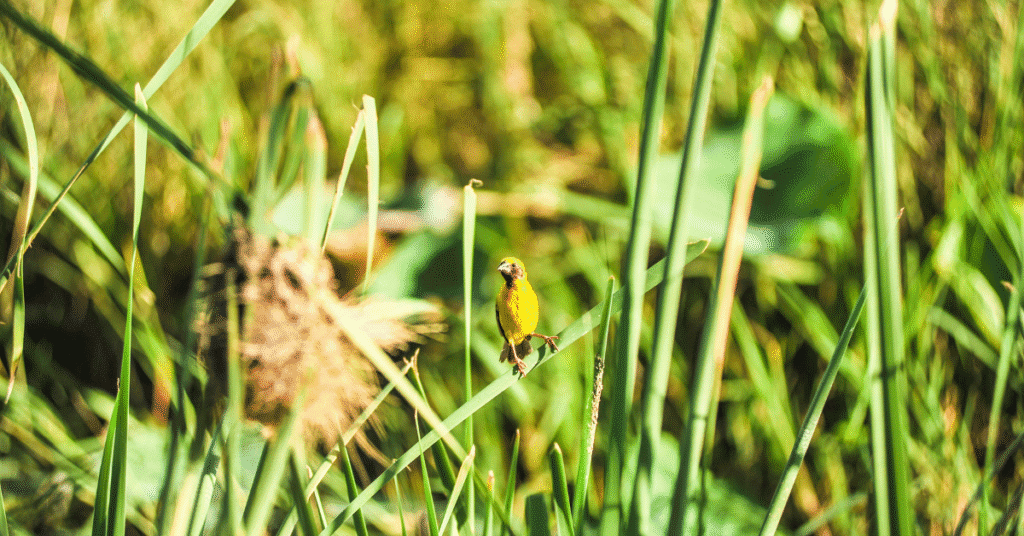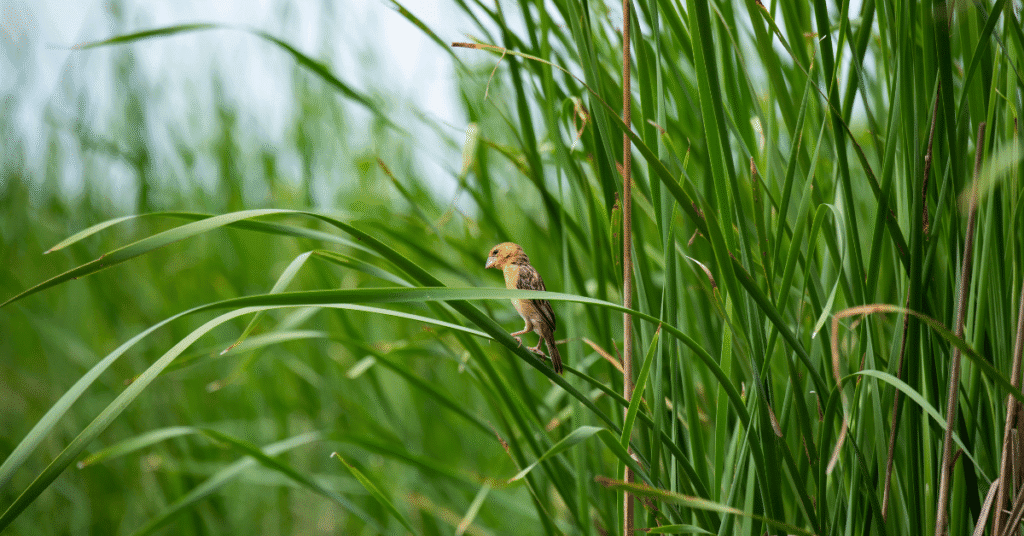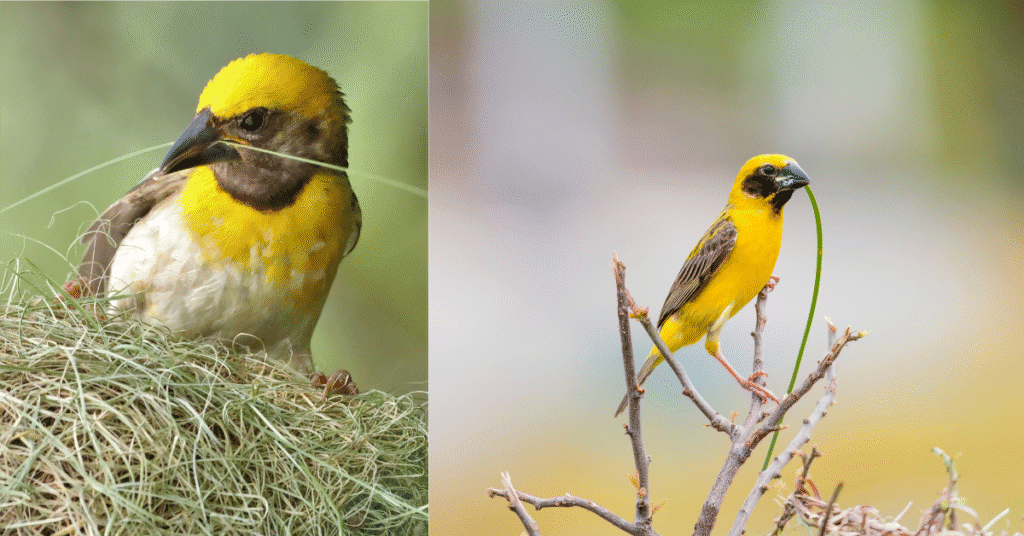Meet the Asian Golden Weaver! Now we know this might not be a name you hear every day, but this little yellow songbird is full of personality. If you’re ever in Southeast Asia, keep an eye out. You’ll be lucky to catch a glimpse of one flashing through the reeds.
The Asian Golden Weaver is currently listed as near threatened globally due to habitat loss resulting from the conversion of wetlands to agricultural and settlement areas. That status means paying attention to their habits and quirks is more urgent than ever.
They’re picky nesters, usually choosing out-of-the-way cattail patches, and their parenting style is surprisingly hands-on for such tiny birds.
Key Facts About the Asian Golden Weaver

This weaver’s golden-yellow feathers, with those striking black facial markings, make it pop against the reeds. Its scientific name, Ploceus hypoxanthus, puts it firmly in the weaver family and hints at its pale yellow shade.
Distinctive Physical Characteristics

Spotting an Asian Golden Weaver is pretty easy once you know what to look for—mostly that vivid golden-yellow coat. At about 14-15 centimeters long, it falls smack in the middle size-wise for weavers.
Male breeding plumage is the showiest, with the head, neck, and underparts glowing gold, while the back and wings are a bit more muted with streaks.
Females and non-breeding males look a bit washed out by comparison, with paler yellow or buff feathers and more pronounced streaks on their backs.
Both sexes sport those classic conical bills perfect for cracking seeds. Their legs? Usually pale pink, occasionally a straw-colored hue. The wings have dark flight feathers that really stand out next to all that yellow.
Unique Identification Markers
The black mask is probably the easiest way to ID an Asian Golden Weaver, especially in breeding males. That mask stretches from the bill, past the eyes, and is darkest during breeding season.
When it’s not breeding time, it’s mask can fade quite a bit. It’s not always a sharp line, so don’t be surprised if it looks a little smudgy.
Key identification points include:
- Bright golden-yellow body plumage
- A black facial mask in breeding males
- Conical seed-cracking bill
- Medium size compared to other weavers
If you’re comparing yellow weavers, the mask’s shape and color intensity are your best clues. That combination of gold and black is truly unique in its range.
Scientific Name and Etymology
The full name, Ploceus hypoxanthus, puts the bird in the true weaver genus—Ploceus comes from Greek for “weaver,” which fits their nest-building obsession.
“Hypoxanthus” is also Greek, roughly meaning “under yellow,” which somewhat describes the bird’s lighter yellow color compared to some of its flashier cousins.
This species was first described back in the 1800s. The name sticks because it pretty much sums up what makes the bird stand out: the yellow plumage and weaving skills.
Having a clear scientific name helps birders and researchers distinguish the species, regardless of the language they’re working in.
Natural Habitat and Geographic Distribution

Asian Golden Weavers are all about wetlands. They gravitate toward reed beds and marshes across Southeast Asia, from Myanmar to Indonesia, with some strongholds in Sumatra.
Preferred Environments and Reed Beds
Most of the time, you’ll run into these birds in marshes and wetlands thick with tall grasses. They seem especially keen on cattail stands and reed beds close to water.
Mature cattails—usually a year or two old—are their favorites for both feeding and nesting. You’ll also spot them in natural grasslands and occasionally in planted lawns.
Key habitat requirements include:
- Proximity to freshwater sources
- Dense reed bed coverage
- Lowland elevations below 500 meters
- Seasonal flooding patterns
Rice fields are another big draw. Flooded paddies mimic their natural habitat surprisingly well, so you’ll often see them there too.
Mixed vegetation seems to be the sweet spot—they use different grass heights for everything from foraging on the ground to tucking nests up high.
Native Range in Southeast Asia
Your odds of seeing an Asian Golden Weaver are best in six Southeast Asian countries: Myanmar, Thailand, Laos, Vietnam, Cambodia, and Indonesia.
In Thailand, they’re spread out across the north, northeast, and central regions, but honestly, they’re never super common.
They stick to lowland areas and like to be near water. Sometimes that’s in forested patches and other times its around natural waterholes in drier spots.
Geographic distribution breakdown:
- Northern range: Myanmar, northern Thailand, Laos
- Central range: Central Thailand, Cambodia, Vietnam
- Southern range: Indonesia (including Sumatra)
These days, their range is pretty patchy thanks to wetland loss. Populations are mostly hanging on in the best remaining spots.
Population Trends and Conservation
The Asian Golden Weaver is Near-threatened, and yeah, that’s mostly due to vanishing wetlands. Populations are dropping, mostly because their habitat keeps shrinking.
The biggest problem is farming. As rice fields keep spreading and wetlands get drained or turned into farmland, these birds are left with fewer places to live and feed.
Plus studies show that urban sprawl along rivers makes it worse. As cities grow, there’s simply less space left for them to nest.
Current conservation challenges:
- Limited quantitative population data
- Habitat fragmentation
- Agricultural intensification
- Urban development pressure
Most conservation efforts are focused on preserving what wetlands remain. If you care about these birds, supporting wetland protection in Southeast Asia is a good place to start.
Presence in Sumatra and Neighboring Regions
Sumatra is a key stronghold for the species in Indonesia. You’ll find them scattered across the island’s marshes and rice paddies. Not only on the, coast but inland too.
Other nearby islands also have populations of the Weavers. Basically, anywhere there are decent wetlands, these weavers try to hang on.
Sumatra habitat characteristics:
- Extensive rice field systems
- Natural freshwater marshes
- Coastal wetland areas
- Lowland elevation zones
Sadly, palm oil plantations are eating into their habitat here too. The trend isn’t great, and suitable wetlands are shrinking fast.
Behavior and Social Structure
Socially, Asian Golden Weavers are pretty fascinating. They form small breeding colonies, and their territorial antics are something to see. Compared to the Baya Weaver, they’re a little less rowdy, but no less interesting.
Small Colonies and Social Life
During breeding season, you’ll usually find them in small, loose colonies, rarely more than 10 or 15 pairs. It’s a far cry from the huge weaver flocks you might expect.
Each pair stakes out its tiny territory within the colony, but you’ll also see them foraging together, especially in reed beds.
When breeding’s over, things get more relaxed. You’ll see small groups of 3 to 8 birds hanging out together. It’s so cute how they’ll share tips on where to find food. And then most importantly warn each other about predators.
Colony characteristics look like this:
- Size: 5-15 breeding pairs maximum
- Territory: Individual nest sites within the colony area
- Seasonal variation: More social during non-breeding periods
- Foraging: Happens in mixed-species flocks
Territorial and Mating Displays
Come breeding time, males get pretty worked up about territory. They’ll defend the best nest spots with gusto, sometimes hanging upside down from reeds to show off.
There’s a lot of chasing and noisy arguments between rival males. The best weaving spots will usually be on reed stems over water.
I saw a clip once where the males were trying to show off during mating season. Despite it being a barely-started nest, they would still hang there and put on the show. In particular flapping like mad and shouting like it was some kind of bird talent show. It was chaotic, but you could tell they were giving it everything they had.
Display behaviors will always include:
- Hanging upside down beneath nest sites
- Beating and flapping their wings
- Persistent calling and chattering
- Aggressive pursuit of rival males
Comparison With the Baya Weaver
If you’ve watched both species, the differences are pretty obvious. Baya Weavers gather in huge colonies—sometimes hundreds of pairs—while Asian Golden Weavers keep things small and simple.
Baya Weavers also have more complex social hierarchies. Asian Golden Weavers stick to basic pair bonds, with less drama overall.
Territorial fights are less intense, too. There’s competition, sure, but nothing like the free-for-alls you see in big Baya Weaver colonies.
Some Key differences between Asian Golden Weavers and Baya Weavers
- Colony size: Asian Golden Weaver (5-15 pairs) vs Baya Weaver (50-200+ pairs)
- Social complexity: Simpler pair bonds vs complex hierarchies
- Territorial behavior: Moderate competition vs intense rivalry
Breeding and Nesting Habits
These weavers are particular about where they breed. They go for cattails and reeds that are a year or two old. If there are overgrown patches they’ll usually steer clear of them. Males handle most of the nest-building, but both parents pitch in once the eggs arrive.
Nest Building Techniques

If you spend a little time watching, you’ll see the males hard at work. They start weaving nests out of cattail leaves and marsh grass. I watched a documentary showcasing how they hang them from strong reeds, and honestly, it’s kind of amazing.
Part of their specialty is pulling long strips from the plants and then twisting and tucking them into these bottle-shaped nests. The nests have little side entrances that help keep out rain and nosy predators.
Key building materials include:
- Fresh cattail leaves
- Reed fibers
- Marsh grasses
- Fine plant strips
They usually start with a simple ring at the top, then build the rest of the nest downward from there. However it takes a few days to finish, and that little entrance tunnel they add is so genius! With this smart move, the chicks will be safer inside.
Role of Males and Females in Raising Young
The males get things started by building a nest and showing off a little to get a female’s attention. Once they pair up, it’s a team effort from there.
The female does most of the sitting, which means she’ll stay on the eggs for around two weeks. This is all while the male sticks close, tweaking the nest and keeping everything in order.
After the chicks hatch, both parents get busy feeding them. Insects, small seeds, and whatever else is packed with protein. All these things on the menu to help those chicks grow fast.
Parental responsibilities:
- Males: Nest building, territory defense, chick feeding
- Females: Egg laying, primary incubation, chick feeding
The young stick around in the nest for roughly three weeks. Even after they fledge, parents continue to bring food until the young ones can manage on their own.
Nesting Sites and Safety Strategies
You’ll usually find Asian Golden Weaver colonies tucked into reed beds and cattail marshes near water. They seem to favor vegetation that’s not too young, not too old, somewhere in that just-right, in the 1-2 year range.
Small bird groups, will have 3-10 pairs, which cluster together. They like to keep their nests close but not crowded, all within the same patch of reeds.
Predator threats include:
- House Crows
- Large-billed Crows
- Black Drongos
- Rufous Treepies
The birds are choosy about nest locations, picking spots with natural cover. Dense reeds hide their nests from predators above, while water keeps most ground threats at bay.
Weather can be a headache, too. Wind and rain sometimes wreck nests, so they look for areas with some shelter from the worst of the elements.
Living in a group has perks. When danger’s nearby, several pairs can spot trouble and sound the alarm, giving everyone a heads-up.
Diet and Feeding Behavior
The Asian Golden Weaver (Ploceus hypoxanthus) leans heavily on seeds and plant materials for its meals. They’re pretty selective foragers, always on the lookout for the best food in their wetland stomping grounds.
Primary Food Sources
Seeds are their go-to, with an apparent fondness for cattail seeds, mainly from mature plants. If you watch them, you’ll notice they’re picky about where they forage.
They also go after seeds from other wetland grasses and sedges. In places where farms and wetlands meet, rice seeds become a big part of their diet.
Plant materials make up most of what they eat:
- Cattail seeds (primary preference)
- Rice grains
- Wetland grass seeds
- Sedge seeds
During breeding season, they’ll mix in a few small insects. That extra protein goes a long way for egg-laying and feeding hungry chicks.
Foraging Strategies
Your Asian Golden Weaver goes in for selective foraging behavior when it’s out looking for food. They don’t just grab whatever, like some birds. They’re pretty picky, usually opting for mature cattail plants instead of the younger ones.
It’s sort of impressive, honestly. These birds mostly forage in shallow water areas and reed beds.
If you watch closely, you’ll spot them clinging to plant stems, using their beaks with almost surgical precision to extract seeds.
Their favorite times to feed? Early morning and late afternoon. It’s a smart way to dodge the worst of the heat and still get plenty to eat.
Territory-based feeding is also a thing for them. Individual birds often return to the same productive spots, sticking to areas rich in mature cattails and other seeds they prefer.
And hey, outside the breeding season, you’ll sometimes catch groups of them foraging together. Makes sense—why not take advantage of a good food patch when you find one?